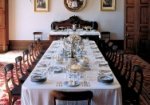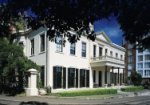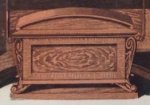Of all the dining rooms in Sydney Living Museums properties, perhaps none have had so many incarnations as that in the Lion of Sydney – Elizabeth Bay House.By looking at just this one room we can watch as the house changes owners, uses and appearance. Today I’m looking at the dining room in the early 20th century, as the house was leased then sold by Macleay descendants, ceased to be a family home altogether and then briefly became a glamorous reception venue.
1911 and new residents: George and Lillian Michaelis
In 1903 James Macarthur-Onslow who had inherited the house leased it to George and Lillian Michaelis, who moved in with their children Alan, Elain and Rupert, and Lillian’s parents Moritz and Sara Gotthelf. 8 years later, in 1911, George purchased the house outright for all of £800.

‘The dining room at Elizabeth Bay House Sydney NSW’. Building, May 12th 1921 p64a. Caroline Simpson Library & Research Collection
In 1921 ‘The Builder’ published an article on Elizabeth Bay House, with views of its interiors. It wrote of the dining room:
From the left and right of the square reception hall opens the drawing room and the dining room respectively…. The former now has a dado of lincustra-Walton designed in eucalyptus leaves and fruit; the converses are heavily curved, the base of the cove standing on a fine egg and dart moulding; the magnitude of the cove being required to proportion with the dimensions of the room. The mantelpiece is of black marble, and though the open fireplace is fitted with a modern electric radiator, this is set in old-time ironwork with supporting dogs, and is in keeping with the dignity of the room. [1]
You can clearly see the decorative ‘tripartite’ scheme of the walls that became popular in the latter 1800s: the lower dado, just taller than the chairs, is of ‘lincustra’ – a tough, easily cleaned product made from compressed linseed oil and powdered wood, and which simulated embossed leather or carved timber – and which we’ll see in closer detail later; the central wall panel is painted a warm red, up to a picture rail which has been added to create a deep frieze section to the upper section of the wall. There is an extension table arranged for 6 diners, with a prominent, armed carver at each end. A sideboard dominates the end of the room, flanked by extra chairs. The room is lit by electric lights, including bracket lights either side of the chimney glass.
1926 was a significant year for the Michaelis family, as Lillian’s father Moritz Gotthelf – a notable philanthropist and significant figure in Sydney’s Jewish community, and who also lived at Elizabeth Bay House – died in early July, and later that year the house was sold:
Elizabeth Bay House, is one of those grand old houses (formerly belonging to the Macleays) that are fitted with everything solid, including the front door, which is opened by a huge key, many inches long. Mr. George Michaelis sold it the other day for £29,000 to Mr. Sydney Snow, and Mr. Snow sold it again for £60,000. A syndicate now owns the place, with its lovely old gardens, and and proposes to erect flats. [2]
Bohemian nights and ‘bright young things’
It was in the following years that possibly the most intriguing and evocative period of the house’s life began. Previous curator Scott Carlin wrote of this decidedly Bohemian period:
The house, isolated on its island block, was purchased by lawyer, property developer and arts patron, Arthur Wigram Allen (1862–1941). Allen was approached by Royal Academician, George Lambert (1873–1930), suggesting that he present the old ‘Macleay House Mansion’ to the nation as artists’ studios.
Allen saw Elizabeth Bay House primarily as an investment but allowed the Melbourne-based academic portraitist, Sir John Longstaff (1861–1941) the occasional use of a studio there. Longstaff retained his studio after Allen sold the house to the Bank of New Zealand in 1932 but was joined by younger artists, Wallace Thornton (1915–1991) and Wolfgang Cardamatis (b1917) who held famous parties ‘amidst the ruins of colonial splendour’. [3]
While artists occupied the top floor, newspaper reports also tell of many fundraisers, parties and balls being held in the ground floor’s large, presumably empty rooms in 1933 – as well as ‘tours’ offered by the caretaker of the house’s “Dungeons, coffin-shute! hangman’s room! the floggers room!’ [4] – in prosaic reality just the cellars. The stage was set for its life as a reception house.
A venue
In August 1934 the house (now on a far smaller, subdivided block) was sold again, and the following year was leased. The artists were evicted to make way for a formal reception house:
Elizabeth Bay House in Decorators’ Hands. Two Enterprising Women’s Venture. Elizabeth Bay House, which the many hundreds of people who have visited it in recent years have regarded as an interesting relic of Sydney’s earlier days, is to be restored in part to its former glory by two enterprising women…
On Monday morning an army of workmen arrived with ladders and scaffolding and commenced immediately to remove the huge shutters which have, for many years now. been closed over the big colonial windows of one of the stateliest mansions ever built along the foreshores of Sydney… By midday all the shutters were off and spread in a neat row along the front of the verandah, where painters already were attacking them with the ground-coat of grey. For Elizabeth Bay House, built by Alexander Macleay in 1837 [sic], and for many years past closed and neglected, has been leased by two enterprising women, Mrs. A. A. Hall and Mrs. L. A. Minnett, and will at last be restored to its original glory…
The dining room, which is finished with an embossed dado, a sample of which a former Governor removed and took back to England to have copied, will be left in its original state except for renovation and will be furnished entirely in mahogany. One beautiful piece selected is an old dining table eighteen feet in length which will seat over thirty people A subsidiary dining room adjoins it…
(The Sydney Morning Herald, 18 July 1935.) [5]
Possibly the first function was a reception was held by the French Consul-General to celebrate the birthday of Victor Hugo:
There was a flavour of Edwardian splendour about the afternoon reception held at historic Elizabeth Bay House yesterday afternoon by the Consul-General for France (M. Meyer) and Madame Meyer, in honour of the occasion of the birthday of France’s national hero, Victor Hugo….
The entrance hall was decorated with a huge alabaster urn in which were arranged lilies, gladioli, and other white blossoms, while the drawing-room was decorated with bowls of arum lilies, one of which occupied a vantage position before a huge gilt mirror at the head of the room, and massed bowls of blue and yellow irises, pink gladioli and carnations, and other lovely blooms….
RED, WHITE, AND BLUE. The long dining-room, where refreshments were served, was made doubly attractive by the use of red, white, and blue flowers In massed bowls on the great long cedar table, obviously a relic of one of Sydney’s mansion houses of a former era. At the head of the table the letters V.H. [‘Victor Hugo’] were carried out in red carnations. (The Sydney Morning Herald, 31st August, 1935.)
This reminds me of a ‘Waterloo Dinner’ that Jacqui and I worked on at Vaucluse House a few years ago, where the initials of Wellington and Nelson were picked out in ivy, red pelargonium flowers and greenery on the tables.
Sideboard in the dining room at Elizabeth Bay House. Possibly taken for ‘The Builder’ magazine, 4th – 5th May, 1937. Hood Collection II State Library of New South Wales: ON 204 Box 104 1 to 22
Now that we can see it more clearly, the lincrusta pattern actually looks like olive leaves and berries to me… Perhaps the writer for The Builder was feeling patriotic. Above, the main wall has been repainted in a pale brown described as ‘maize’, and the ‘tapestry’ can be seen. The floor has a rug with a patterned border, set in from the walls several feet to show the floorboards. The first wedding was that of stage stars Leah Madeleine (‘Madge’) Elliott and Cyril Richards on September 13th, when a sizable crowd gathered outside to watch the couple and their 300 guests arrive. [6]
It was the first of many wedding receptions held there:
‘Sands-Cracknell wedding, Elizabeth Bay House’, November 1936. State Library of New South Wales, Hood collection: 29943
“If you’re seen anywhere with your hat off, wear a Marcel wave in your hair”
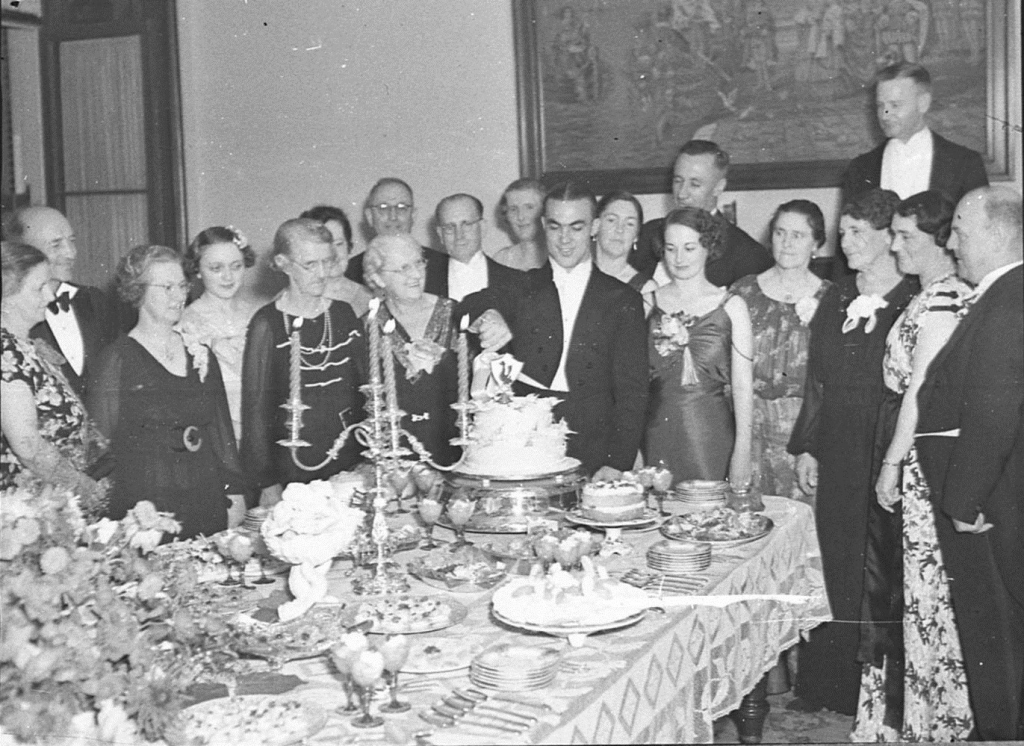
‘Mr Rigby 21st birthday Elizabeth Bay House’, 30th January 1937. State Library of New South Wales, Hood collection: Home and Away – 13905
…and a cheesy grin.
21 st Birthday Dance: In honour of their son, Mr Alec Rigby, who celebrated his twenty-first birthday, Mr. and Mrs. A. L. Rigby, of Burwood, entertained at a young people’s dance at Elizabeth Bay House on Saturday night. The guests were received by Mrs. Rigby, who wore a gown of white American romaine figured in black, blue, and maize. [7]
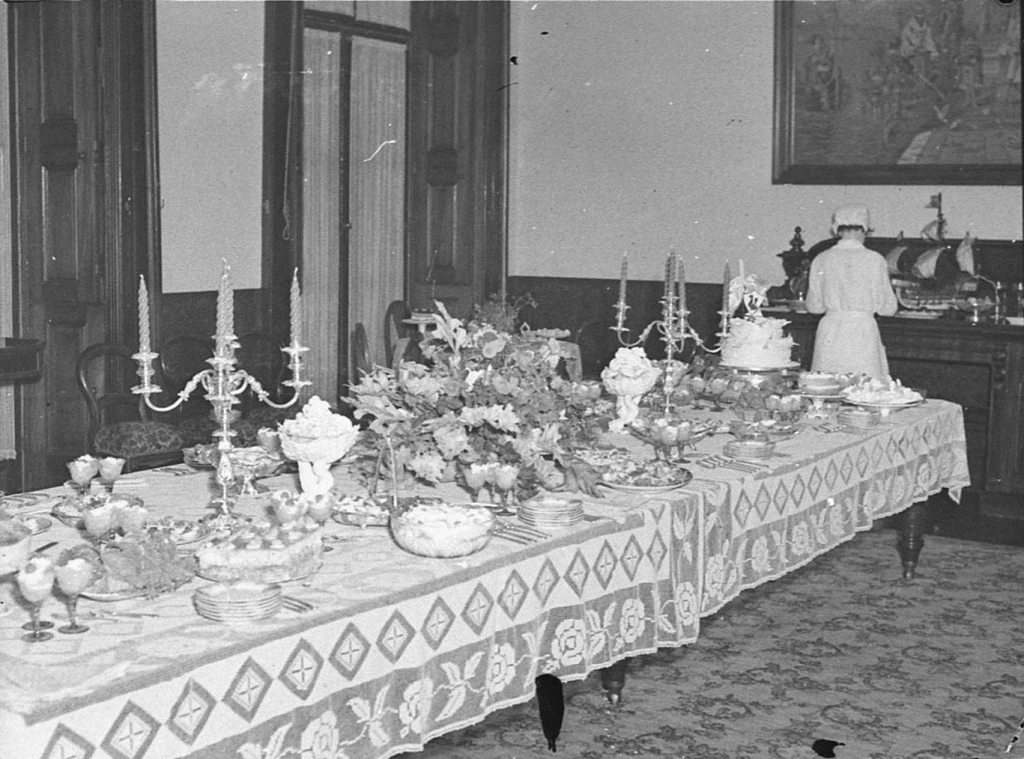
The supper table set for Alec Rigby’s 21st birthday at Elizabeth Bay House, 30th January, 1937. State Library of New South Wales, Hood collection: Home and Away – 13900
Alec’s party featured a buffet supper table, with trifles and cakes, and the spacing suggests hot canapes were brought out when ready. The galleon on the sideboard adds a certain masculine touch. As with Alec’s mother’s dress, fashion at the events held at the house was eagerly reported:
The cocktail hour gives smart women the ideal opportunity to wear the hats of every “crazy” shape so smart this season, and at a late afternoon party at Elizabeth Bay House yesterday, each fresh instance of the designers’ eccentricity was attractive.
(The Sydney Morning Herald, Saturday 28 May 1938)
Oh, the excitement of it all!
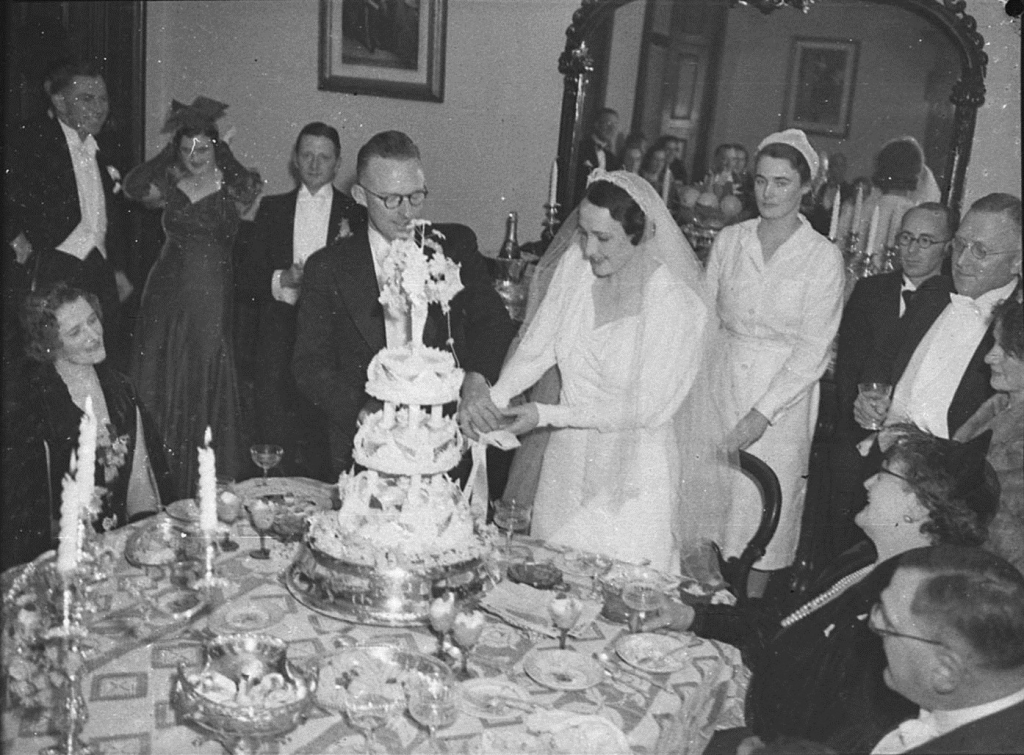
Lorna Elizabeth Englert & Edward William Howitt wedding, July 2nd 1938. State Library of NSW, Hood collection: Home and Away – 18264
By July 1838 we can see some redecoration had taken place, as a new sideboard with a tall arch-topped mirror now dominates the room – though that tablecloth is getting a good run for its money, and have you noticed spiral candles are de rigeur? The staff-member holding the bride’s chair is just beside herself with excitement, as is her colleague who mans the bar which has been set up in the alcove that links the saloon with the dining room behind (note the telephone and, hang on, is that a hole in the cloth?); the door behind him opens into the dining room so he can serve both spaces:
Drinks servery at the reception for the Lorna Elizabeth Englert & Edward William Howitt wedding at Elizabeth Bay House. State Library of New South Wales, Hood collection II: Home and Away – 18259
A few months after Alec’s party Jean Gillespie, from a socialite family, celebrated her own 21st with a midnight party. White camellias decorate her cake, the table is set without a cloth and there are plates of canapes:

‘Jean Gillespie’s 21st birthday party, Elizabeth Bay House’. State Library of New South Wales, Hood collection: Home and Away – 19759
About the catering…
Cake and refreshments at a wedding reception at Elizabeth Bay House. State Library of NSW, Hood collection II: PXE 789 v60
Have you noticed something about all these parties? It seems management had a somewhat limited repertoire when it came to the refreshments: the same glasses of fruit balls and cream topped with a strawberry, the same comports (of glacé fruits?) and the same canapes seem to be in every scene. While this table is set with individual places, most show the table more as a buffet with stacked plates ready for use, though the arrangement is pretty much identical – and really it’s barely different to a supper table in a Mrs Beeton guide from the 1880s. And yep, there’s that tablecloth again.
The end of a (very brief) era
ELIZABETH BAY HOUSE SOLD. Conversion to Flats. Elizabeth Bay House, well known in recent years for its wedding receptions and other social functions, will shortly be converted into a block of residential flats.
The property was sold by Elliott and Co., King’s Cross, on behalf of the vendors. Elizabeth Bay House Estates, Ltd., to an investor. Terms of sale have not been disclosed, nor has it yet been decided whether the building will be demolished and a new block of flats erected, or whether the present structure will be remodelled. It was stated yesterday that the rooms of the building generally are so large that most of them would be sufficient for a self-contained flat dwelling.
Sydney Morning Herald, 13th December 1940
After 5 busy years the doors closed on the venue at the end of 1940, and a the builders again descended on Elizabeth bay House. For what happened next, stay tuned for part 2.
Second helpings
[1] ‘Building’ magazine, May 12, 1921. Lincrusta-Walton is one of those decorative products that really characterizes so many late 19th century interiors. This contemporary quote promotes its durability and new styles:
New Effects in ‘Lincrusta-Walton’ – Lincrusta Walton is making great strides in popularity. Some of the latest additions to their large -range of patterns are in silk and leather effects and are attracting considerable attention. Both these effects show wonderful skill in their manufacture; the silks have a sheen equal to that of any real silk, whilst the leathers have just that grain and suggestion of solidity that is inseparable from any really good skin. Mention must also be made of their new mahogany pattern and its borders; both the filling and borders arc faithful reproductions in every detail of that much-sought-after wood. The durability of Lincrusta is unsurpassed. The idea that its use is confined to palatial houses and public buildings is quite wrong; on the contrary it is excellently suited to any working-class homes, especially for the narrow passages in such, where knocks are very often unavoidable. Its slightly higher cost is outweighed by its durability.
‘The Painters’ Page’ in Construction and Local Government Journal, Monday 2 May 1921, p14.
[2] Canberra Times, 13th January, 1927. Thankfully the proposal to ‘erect flats’ on the site never progressed.
[3] See Scott Carlin, ‘Kings Cross: Bohemian Life in Sydney‘.
[4] Sydney Mail, 18th October, 1933
[5] The redecoration was reviewed a few months later: “How those cream-washed walls above the stamped leather paneling [repainted wall above the lincrusta dado] must have resounded in their day to early colonial shouts of laughter! And how the delicate molding round the cornice must have lost sight of itself before the flickering light of candles managed to penetrate so far up into the gloom. Today the owners have left this room most commendably untouched by anything like curtains to cover the wide cedar splay boards round three long windows. Pictures are also wisely restricted, and there is now just one large piece pf tapestry – a lovely lady embarking from her gondola in front of the Doge’s Palace in Venice.” Peggy Macintyre, ‘Wake up and Dream’ in Decoration and Glass magazine, November 1st, 1935.
[6] There are more photographs of the Elliott-Richards wedding here, including the couple standing at the French doors of Elizabeth Bay House.
[7] ‘Social and personal’, Sydney Morning Herald, 1st February 1937.

